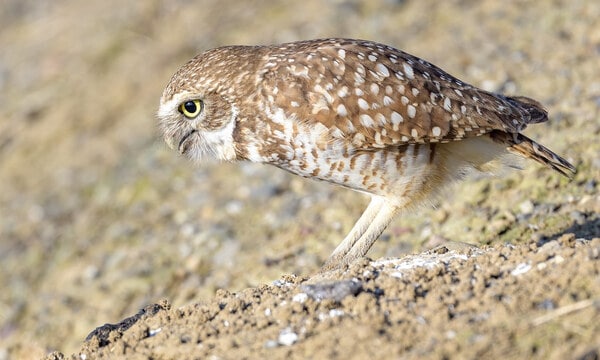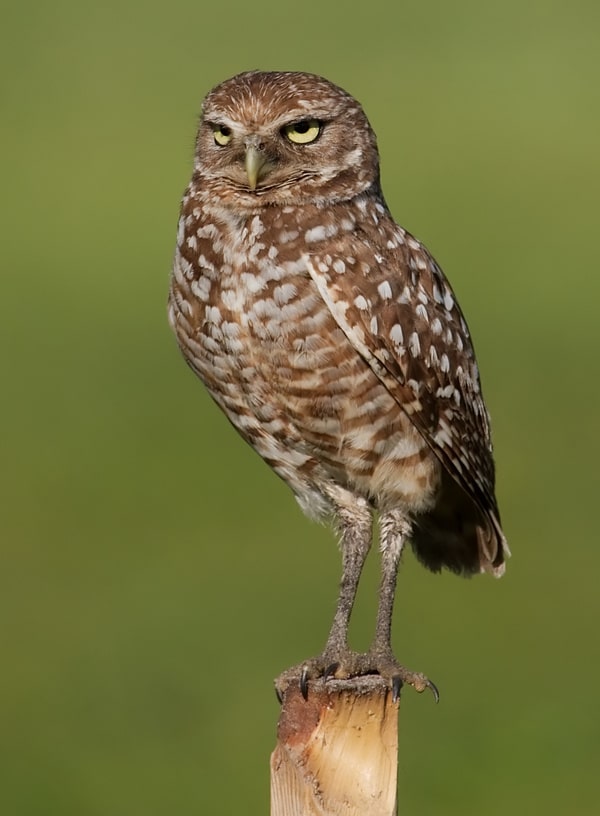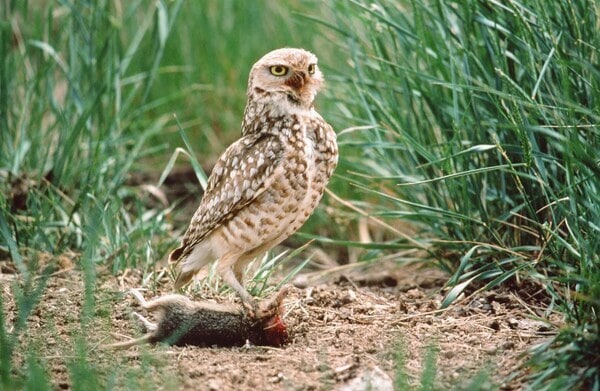The burrowing owls prefer to eat small mammals and insects, such as beetles and grasshoppers. They are also opportunistic feeders and spend a lot time foraging so they will chase down any small prey they can safely attack.
They eat mainly grasshoppers and dung beetles as well as many other large insects in mid-air. They are very opportunistic hunters, and will hunt small mammals such as mice, rats, ground squirrels or young cottontail rabbits. They also eat scorpions, amphibians and small reptiles that are found in their areas.
This word refers to Athene, the Greek goddess wisdom and knowledge. Her favorite bird was the owl. Latin term “cunicularia”, which means “burrower” or “miner”, is the Latin name. The scientific name of the entire species is “wise burrower”.
It was once believed that the dung these owls gather helps to mask the scent of baby owls. Researchers now believe that it helps to control the microclimate in the burrow, and attracts insects for the owls.


How often do burrowing owls eat?
Adult burrowing owls typically need to eat every day or every other day to maintain their energy levels. Juvenile owls, on the other hand, may need to eat more frequently, sometimes several times a day, to support their rapid growth and development.
In the wild, burrowing owls are opportunistic feeders and will eat whatever prey is available to them. They hunt by swooping down from a perch or hovering in mid-air, and they use their sharp talons to grab their prey. Burrowing owls have been known to eat a wide range of prey, including insects, small mammals, reptiles, and birds.
Burrowing owls are also known to store food in their burrows for later consumption. This behavior is more common in females than males and is thought to be a way for the female to ensure that she has a steady supply of food while she is incubating her eggs or caring for her young.
In captivity, burrowing owls are usually fed a diet of mice or rats, and they may be fed once a day or every other day, depending on their age and activity level. It’s important to provide these birds with a varied diet that includes a mix of protein, fat, and carbohydrates to ensure that they are getting all the nutrients they need.
In summary, burrowing owls typically need to eat every day or every other day to maintain their energy levels, and they will eat whatever prey is available to them. Juvenile owls may need to eat more frequently to support their rapid growth and development, and female owls may store food in their burrows for later consumption.


How do Burrowing Owls find food?
One of the primary ways that burrowing owls find food is through their excellent vision. These birds have large, forward-facing eyes that provide them with binocular vision and depth perception, which helps them to accurately judge the distance to their prey. They also have excellent color vision and can see in low light conditions, which allows them to hunt during the day and at night.
In addition to their vision, burrowing owls also use their hearing to locate prey. They have asymmetrical ear openings that allow them to pinpoint the location of sounds, which is particularly helpful when hunting in the dark. They are also able to hear higher frequency sounds than humans, which helps them to detect the high-pitched sounds made by small prey such as insects.
Burrowing owls are also known to use their sense of smell to find food, although this is not their primary hunting method. They have a small, but functional, olfactory bulb in their brain that allows them to detect odors. This sense of smell may be particularly helpful when searching for prey that is hidden underground or in dense vegetation.

Once a burrowing owl has located its prey, it will use its sharp talons and hooked beak to capture and kill it. Burrowing owls are also known to store food in their burrows for later consumption, which is especially helpful during times when food is scarce.
In conclusion, burrowing owls use a combination of their excellent vision, hearing, and sense of smell to locate and catch their prey. They are opportunistic hunters that will eat a wide range of prey, and they use a variety of hunting techniques to capture their food. These small but mighty birds are fascinating to watch and study, and they play an important role in their ecosystems as predators of small animals.
What time of day do Burrowing Owls feed?
Burrowing owls are particularly active during the early morning and late afternoon hours, which is when their prey is most active. In the early morning, they may hunt for insects that are just becoming active, while in the late afternoon, they may hunt for small mammals or birds that are preparing to settle in for the night.
At night, burrowing owls may continue to hunt, especially during periods of low light when their prey may be more active. They are also known to hunt during the early morning and late evening hours when there is still some daylight available.
During the breeding season, burrowing owls may adjust their feeding habits to accommodate the needs of their young. They may hunt more frequently during the day to provide enough food for their chicks, who have high energy needs.
In conclusion, burrowing owls are active hunters that will feed whenever prey is available to them. They are particularly active during the early morning and late afternoon hours, when their prey is most active, and they may continue to hunt during the night and early morning and late evening hours when there is still some daylight available. These small but mighty birds are fascinating to watch and study, and they play an important role in their ecosystems as predators of small animals.
What Do Burrowing Owls Eat In The Winter?
In the winter, burrowing owls may have fewer prey options than they do in the warmer months. Insects, which make up a significant portion of their diet, may be less abundant in the winter due to the colder temperatures. However, burrowing owls are resourceful hunters and will adapt their diet to the available food sources.
One common prey item for burrowing owls in the winter is small mammals, such as voles, mice, and shrews. These animals are active throughout the winter and can provide a reliable food source for burrowing owls. Additionally, burrowing owls may also feed on birds, such as sparrows, finches, and doves, which can be found in the winter in areas where there are bird feeders or other food sources.

In some areas, burrowing owls may also feed on reptiles in the winter, such as lizards or snakes, which are active even in cooler temperatures. They may also hunt for insects in areas where they are still present, such as in microhabitats like leaf litter or under bark.
Overall, burrowing owls are adaptable hunters and will adjust their diet to the available food sources in the winter. While insects may be less abundant, they can still rely on small mammals, birds, reptiles, and other prey items to survive the colder months. These small but mighty birds are fascinating to watch and study, and they play an important role in their ecosystems as predators of small animals.
What do Burrowing Owls Eat during Spring and Summer?
During the spring and summer, burrowing owls have access to a wide variety of prey items, as many animals become more active during the warmer months. Insects are a common food source for burrowing owls during this time, and they may feed on a variety of insects, including grasshoppers, beetles, and crickets. Insect abundance can vary depending on the region and the amount of rainfall, but in general, burrowing owls are able to find plenty of insects to eat during the spring and summer.
Small mammals are also an important food source for burrowing owls during the spring and summer. They may prey on rodents such as mice, voles, and ground squirrels, which are active during the day and night. In some areas, burrowing owls may also prey on rabbits or hares, which are larger animals that provide a substantial amount of food.
Birds can also be a food source for burrowing owls during the spring and summer. They may prey on birds that are nesting on the ground, such as sparrows, finches, and doves. Additionally, they may also feed on young birds that have recently fledged and are still learning to fly.

Reptiles, such as lizards and snakes, are another potential food source for burrowing owls during the spring and summer. These animals are more active during the warmer months and can provide a reliable food source for burrowing owls.
Overall, burrowing owls are adaptable hunters and will adjust their diet to the available food sources during the spring and summer months. They are able to find plenty of prey items, including insects, small mammals, birds, and reptiles, to sustain themselves and their young. These small but mighty birds are fascinating to watch and study, and they play an important role in their ecosystems as predators of small animals.
What do baby Burrowing Owls eat?
Baby burrowing owls, also known as owlets, have specific dietary needs that are different from adult burrowing owls. As they grow and develop, their diet will change to reflect their changing nutritional needs.
When owlets hatch, they are completely dependent on their parents for food. Initially, they are fed a diet of small insects such as grasshoppers, crickets, and beetles, as well as spiders and other arthropods. As they grow, their diet will gradually shift to include larger prey items, such as small mammals, birds, and reptiles.
As they get older, owlets will begin to hunt for their own food, although they may still be fed by their parents for a period of time. They will start by hunting insects and small prey items before moving on to larger prey as they become more skilled hunters.
It’s important to note that baby burrowing owls have specific nutritional requirements, and they need to receive a diet that is high in protein and other essential nutrients to support their growth and development. In the wild, their diet will vary depending on the availability of prey items in their environment.
Overall, baby burrowing owls eat a diet that is similar to adult burrowing owls but with a greater emphasis on small insects and arthropods early on in their development. As they grow and develop, they will gradually shift to larger prey items and begin to hunt for themselves.

Are Burrowing Owls Omnivores?
Burrowing owls are not considered omnivores as they primarily feed on animal prey. They are carnivorous birds of prey, which means that their diet consists mainly of small mammals, birds, reptiles, and insects.
While they do not typically eat plants, burrowing owls have been known to consume small amounts of vegetation on occasion. For example, they may consume seeds or berries that are found in their burrowing areas, but this is not a significant part of their diet.
In general, burrowing owls are opportunistic hunters that will take advantage of a wide range of prey items that are available in their environment. Their diet will vary depending on the region they inhabit and the time of year, with different prey items being more abundant at different times of the year. However, they are primarily carnivorous and rely on animal prey to meet their nutritional needs.
Related Post :
- Do Owls Eat Fish : Read The Explanation
- Do Owls Eat Birds : Let’s Understand Why
- Do Hawks Eat Owls – Explanation
- Do Owls Eat Chickens – Explanation
- Do Owls Eat Squirrels – Explanation A To Z
- Leucistic Owls: Understanding a Rare Genetic Phenomenon
- Do Barred Owls Eat Squirrels : Uncovering the Truth
- Barn Owl Skull: A Look into Nature’s Design
- Barn Owl Feet: Understanding the Unique Anatomy
- Tawny Fish Owl: Facts, Habitat, and Conservation Efforts
- Rufous Owl : A to Z Guide
- What Does A White Owl Mean : A to Z Explanation
- Do Owls Eat Birds : Let’s Understand Why
- Baby Great Horned Owl – A to Z Guide
- Flammulated Owl : A to Z Guide
